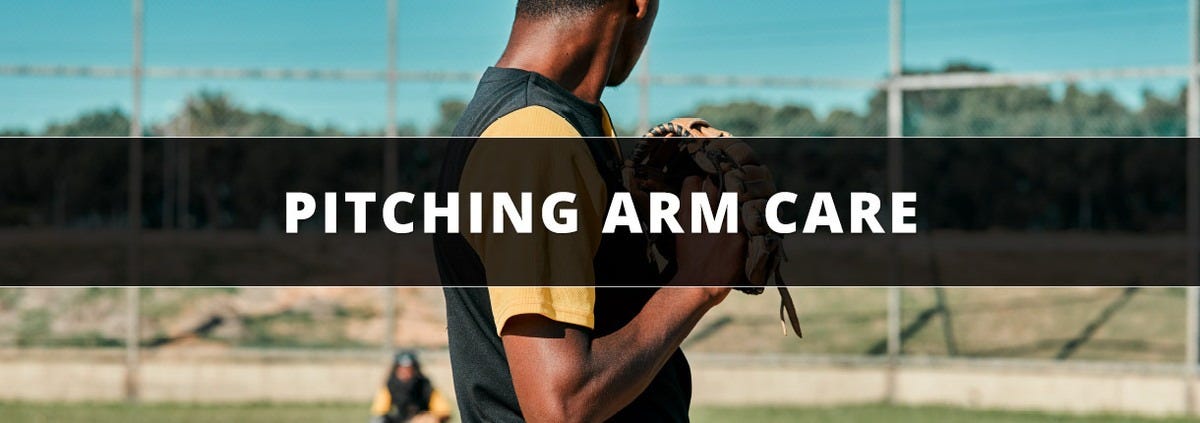Pitching Arm Care FAQ

Pitching arm care is a controversial topic in the baseball world. There is a lot of conflicting information online on what is best for training and recovery methodology. Fortunately, this has brought about an increase in the quantity of research studies into the topic resulting in a better understanding of what is best for athletes. In this article, we will address some of the most frequently asked arm care questions along with introducing some great training products to help you strengthen your arm while staying healthy. You can check out our full selection of pitching training aids.
In this article, we’ll cover:
- Icing Your Arm After Pitching FAQ
- How to Treat a Sore Pitching Arm FAQ
- How to Take Care of Your Pitching Arm FAQ
Icing Your Arm After Pitching FAQ
In this section, we’ll break down some of the most common questions surrounding the application of ice after throwing. The sight of pitchers with ice packs strapped to their shoulders and elbows after pitching is iconic in baseball history. However, it might not always be the best solution. Keep reading to learn why!
Should you ice your arm after pitching?
Let's start at the top and examine why you might feel that you need to ice your arm. Some pitchers might feel a soreness after throwing in their shoulder, arm, or elbow. It is important to identify what type of pain you are feeling. You should never be in extreme discomfort with sharp pains or decreased mobility after throwing. If you are, this is a deeper issue than soreness, and medical help is recommended.
If you are just experiencing general soreness after throwing, what you are feeling is from micro tears in the muscles, tendons, and ligaments that happen from throwing. This is often called microtrauma, and your body is equipped to repair it naturally by sending cells to the area via blood flow.
With this knowledge, let's look at what happens when you ice. The primary function of icing is to reduce swelling and inflammation around an injury by slowing blood flow to the area. It becomes apparent that icing stops the very thing you need after throwing, blood flow.
In conclusion, if you are dealing with general soreness after throwing, it is best to avoid icing and replace it with techniques that promote blood flow and the full range of mobility.
Is icing your arm after pitching bad?
If you experience intense pain in your arm following pitching, applying ice can indeed assist in diminishing pain, swelling, and inflammation. The presence of intense or sharp pain warrants the guidance of a medical professional as it signals an underlying issue.
However, in the absence of sharp pain, using ice may impede the natural recovery process by reducing blood flow to the pitching arm. After a throwing session, your arm undergoes a healing and repair phase, where adequate blood flow is beneficial. Instead of icing, choose a recovery process that promotes blood flow and full range of motion.
How long should I ice my arm after pitching?
Icing isn’t necessary if you don’t have sharp pain. However, if you do ice, you should do it immediately after experiencing the sharp pain. Icing to reduce acute inflammation works best if it is done within 30-60 minutes of the trauma. Leave the ice on your arm for no more than 15-20 minutes, then let the arm return to normal temperatures.
How to ice arm after pitching?
It is no longer recommended to ice your arm after pitching unless you are dealing with extreme discomfort, sharp pain, or decreased mobility. Nevertheless, if you choose to ice, it is advisable to do so promptly after encountering the sharp pain. The most effective application of ice for reducing acute inflammation is within the initial 30-60 minutes following the trauma. Limit the duration of ice application on your arm to 15-20 minutes and allow the arm to gradually return to its normal temperature.
What should you do instead of icing after pitching?
Instead of icing, it is better to do a form of active recovery. One of the simplest forms of active recovery is running. This gets the heart pumping, providing your arm with plenty of blood that contains healing cells to help repair the microtrauma caused by throwing. If running is not for you, you can try a stationary bike, walk, or swim. This increases general blood flow throughout the body and prepares the body for a post-performance flexibility routine. Increasing blood flow allows the body to circulate oxygenated blood to fatigued muscles. Oxygenated blood helps soft tissues recover and heal following. The goal is to do a form of active recovery substantial enough to get your blood flowing and the healing process underway.
In addition to active recovery, you can also incorporate targeted techniques to promote blood flow and mobility. This includes foam rolling, stickwork, massage gun, and providing heat to the area. Also important is taking the arm through a full range of motion in stretches. Along with increasing the flow of oxygenated blood to muscles and tendons, stretching following an athletic performance helps to relax soft tissues while mediating the by-products of exercise that make the body stiff and sore.
Should you ice your arm before pitching?
No, never ice your arm before pitching. Instead, try and get the blood flowing in your arm through a dynamic warmup. You also want to stretch your arm through its entire range of motion before pitching. In addition to playing catch, a great way to do this is through bands or plyometric balls.
Is it better to ice or heat your arm?
Ice should only be applied if you are dealing with sharp pain or injury to the arm from throwing. The preferred way to recover after throwing is to promote blood flow via active recovery of targeted recovery techniques.
Do ice baths help pitchers?
An ice bath can be beneficial for recovery. However, it needs to be done smartly. You should never get directly into an ice bath after throwing as it can slow the recovery process down. If you do want to try an ice bath for recovery, it is best to do so 24, 48, and 72 hours after the stimulus of a workout or game occurs.
How to Treat a Sore Pitching Arm FAQ
In this section, we’ll break down some of the most common questions surrounding dealing with a sore pitching arm. Arm soreness should be taken seriously as it can be a sign of larger issues. Keep reading to learn why your arm is sore, and what you can do to treat the issues at the core.
Why does my arm hurt after pitching?
Some pitchers might feel soreness after throwing in their shoulder, arm, or elbow. It is important to identify what type of pain you are feeling. There is a difference in general soreness and sharp pain. You should never be in extreme discomfort with sharp pains or decreased mobility after throwing. If you are, this is a deeper issue than soreness, and medical help is recommended.
If you are dealing with general soreness, what you are feeling is from micro tears in the muscles, tendons, and ligaments that happen from throwing. This can happen for a few reasons. First, you have worked your arm past its current strength which results in micro-trauma to muscles. This is not a bad thing as it is required to get stronger. However, soreness can also be a sign that there is an issue with your throwing mechanics. Perhaps you are not utilizing other muscles when throwing which is placing too much of the workload on your arm resulting in soreness. Consult a coach for a mechanical evaluation if you feel that this might be contributing to your soreness.
Does pitching hurt your arm?
Pitching does place a significant amount of stress on the arm, especially the shoulder and the elbow. The repetitive motion under heavy load can stain the muscles, tendons, ligaments, and joints on the pitching arm. It is common to have fatigue and even a little soreness after throwing, but you should never have severe or persistent pain in the arm. This is a sign that there is a more serious underlying issue that should be addressed by a medical professional.
How do you take care of your arm after pitching?
Opt for active recovery instead of icing. Simple activities like running, stationary biking, walking, or swimming boost blood flow, delivering healing cells to repair microtrauma from pitching. This increased blood circulation readies the body for post-performance flexibility routines, aiding muscle recovery. Incorporate techniques like foam rolling, stickwork, massage gun, and heat application for targeted blood flow and mobility enhancement. Stretching after activity relaxes soft tissues, promoting oxygenated blood flow and mitigating stiffness and soreness. The goal is an active recovery substantial enough to initiate the healing process.
What to do immediately after pitching?
Immediately after pitching is it best to promote blood flow to the arm through active recovery. You will have experienced some micro trauma from pitching and blood contains cells that help repair that trauma. One of the simplest forms of active recovery is running. This gets the heart pumping, providing your arm with plenty of blood that contains healing cells to help repair the microtrauma caused by throwing. If running is not for you, you can try a stationary bike, walk, or swim. This increases blood flow and allows the body to circulate oxygenated blood to fatigued muscles. Oxygenated blood helps soft tissues recover and heal following. The goal is to do a form of active recovery substantial enough to get your blood flowing and the healing process underway.
In addition to active recovery, you can also incorporate targeted techniques to promote blood flow and mobility. This includes foam rolling, stickwork, massage gun, and providing heat to the area. Also important is taking the arm through a full range of motion in stretches. Along with increasing the flow of oxygenated blood to muscles and tendons, stretching following an athletic performance helps to relax soft tissues while mediating the by-products of exercise that make the body stiff and sore.
Should I throw the day after I pitch?
Especially for those who threw a lot of pitches, it is not recommended to throw again the next day. The day after you pitch is an important day in the recovery process, and other activities are more beneficial than throwing. For example, a dynamic warmup helps engage the nervous system and increases blood flow to muscles to aid in recovery. It is also a good idea to engage in more active recovery for the day after you pitch. This is any form of cardio that gets your heart rate up and your body moving. Finally, stretching is a great way to open up more muscle fibers and expedite the recovery time by allowing oxygen-rich blood to bring in the cells needed for repair.
How to Take Care of Your Pitching Arm FAQ
In this section, we’ll break down some of the most common questions surrounding taking care of your pitching arm. Whether you are a pitcher only, or play another position, keeping your throwing arm healthy is vital. Having a sore arm not only affects your performance on the field but also your enjoyment of the game. Keep reading for some tips on keeping your arm healthy all season long.
How do I keep my pitching arm healthy?
The first way to keep the arm healthy does not involve the arm at all. Baseball players need to keep their entire body in top shape to avoid arm injuries. Oftentimes when we are weak in one area, our arms will work too hard to counter which can result in injuries. Specifically, consider your pelvic stability, core, lower body strength, and overall flexibility. A healthy arm starts with a healthy body.
Next, pay attention to your throwing mechanics. Improper form can place unnecessary stress on the arm which can result in injuries. For example, stay closed when you throw. If you start to rotate open too soon in your delivery, you will lose momentum and lack torque which in turn will put all the pressure on your arm joints to try and create power. Momentum down the mound and late turn/torque creates most of the power and takes the strain off the arm.
Finally, listen to your body and arm. You want to stretch your limits as that is where strengthening occurs. Throw long and throw hard as often as possible. If it needs a break, give it a day off. Overthrowing is detrimental to your arm health. Oftentimes a day off will restore your arm to full health.
Is heat good for a sore pitching arm?
Heat is an option for a sore pitching arm, but it is not always the best option. Instead, Opt for a form of active recovery. Simple activities like running, stationary biking, walking, or swimming boost blood flow, delivering healing cells to repair microtrauma from pitching. This increased blood circulation readies the body for post-performance flexibility routines, aiding muscle recovery. Incorporate techniques like foam rolling, stickwork, massage gun, and heat application for targeted blood flow and mobility enhancement. Stretching after activity relaxes soft tissues, promoting oxygenated blood flow and mitigating stiffness and soreness. The goal is an active recovery substantial enough to initiate the healing process.
What causes dead arm in pitchers?
”Dead Arm” is another word for fatigue. It often feels like a dull ache in the arm with a drop in throwing velocity and is caused by overuse or poor mechanics. Dead arm can be avoided by good arm care, resting, building strength, and fixing mechanical issues.
Are push-ups good for pitchers?
Pushups are a great exercise for pitchers when done correctly and with purpose. They engage multiple muscles are the same time and provide the benefit of improved core strength, upper body strength, stability, and endurance. However, they are not the only exercise pitchers should be doing. Squats, deadlifts, and other movements are weightlifting workouts that assist in building general strength and power, which can improve pitching velocity. Pitchers should add a combination of pushups and weightlifting exercises into their training plan for the best results.
What exercises should pitchers not do?
In addition to pushups, pitchers should do exercises such as squats, deadlifts, and explosive weightlifting workouts that assist in building general strength and power, which can improve pitching velocity. Medicine ball tosses, resistance band exercises, plyometric drills, and weighted ball training are all useful activities. These workouts work specific muscle areas to build power and explosiveness, which can lead to greater pitching velocity.
Are pull-ups bad for pitchers?
Pull-ups are not the best exercise for pitchers. As they can place strain on the elbows and lead to muscle imbalances. If you are trying to strengthen your back, look at inverted pull-ups (also called the inverted row), rows, and deadlifts. When it comes to strength training, the goal for pitchers is to be fast, powerful, and explosive.
Is overhead press bad for pitchers?
Pitchers need to be careful when performing overhead lifts. They can place stress on the shoulder area which can lead to injury. Avoid doing moves in the “high five” position. Instead, use a neutral grip to take stress off the shoulder. For pitchers, it is better to lower the weight and focus on high reps with a full range of motion on shoulder exercises.
Is it bad for pitchers to lift weights?
No, lifting weights is extremely beneficial for pitchers. They just need to be smart about it.
To enhance their overall performance and cultivate a versatile skill set, pitchers should include a mix of exercises in their training routine. Beyond pushups, incorporating squats, lunges, shoulder exercises, and core workouts is essential to target diverse muscle groups involved in pitching. A comprehensive training program is pivotal for pitchers to develop the strength, power, and endurance crucial for optimal pitching velocity.
What is the most important muscle for pitchers?
You might think that the most important muscle would be the arm. However, the foundation of a strong arm is a strong core. The core offers stability, balance, and power when throwing. In addition to a strong core, pitchers need to have a strong lower body to stay explosive when throwing. Once these two groups are addressed, you can then begin to focus on other groups such as the back and upper body.
How do pitchers get stronger?
The best way to get stronger is through a combination of weight, fast twitch, and mobility training. Weight training is a great option for increasing your overall strength and power. Fast twitch will increase your overall explosiveness, a vital component when it comes to gaining velocity. Mobility training will help you stay healthy and reduce the risk of injury.
How do pitchers build arm strength?
There are two methods for building arm strength that need to be used together. The first begins in the gym. When you enhance your muscular strength, power and endurance will improve as well. However, this is not enough. You must throw to keep your arm conditioned and build your strength throughout the throwing motion. A great option for taking your arm to the max of its conditioning is through long toss and pull-downs. These throwing activities will help you build the throwing motion strength you need along with the strength you are building in the gym.
Why do pitchers rest so much?
Rest and recovery are vital for pitchers. Long outings can take a toll on the entire body, especially the arm. Rest allows your body to heal from any micro-traumas that you might have experienced from throwing. Getting adequate rest reduces your risk of injury and allows you to return to peak performance. In addition to resting, pitchers should engage in a form of active recovery, getting enough sleep, and staying hydrated.
Shop Our Selection of Pitching Training Aids at Baseball Monkey
The world of pitching arm care is full of controversy and conflicting advice. This article provides clarity on some of the most pressing questions on training, recovery, and overall arm health. It serves as a guide on the intricacies of icing, treating sore arms, and arm strengthening. The key takeaway is the importance of active recovery to help your arm heal and get you back on the mound as soon as possible. As you look to strengthen your arm, keep this guide as a valuable resource, and if you need any pitching training aids, you can view our full section here.








